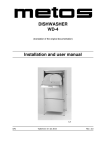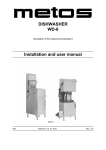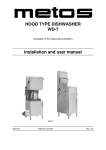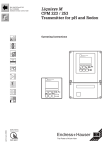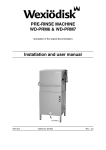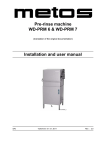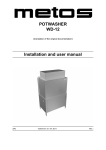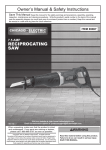Download DISHWASHER WD-4C Installation and user manual
Transcript
DISHWASHER WD-4C (translation of the original documentation) Installation and user manual S/N: Valid from: 01. 11. 2011 Rev.: 2.0 WD-4C Rev. 1. General .............................................................................................. 1 1.1 Symbols used in this manual ........................................................................... 1 1.2 Symbols on the dishwasher ............................................................................. 2 1.2.1 Machine marking ...................................................................................... 2 1.3 Checking agreement between the appliance and the manual ......................... 2 2. Safety instructions ........................................................................... 3 2.1 General ............................................................................................................ 3 2.2 Transport .......................................................................................................... 3 2.3 Installation ........................................................................................................ 3 2.4 Detergent and drying agent ............................................................................. 4 2.5 Operation ......................................................................................................... 4 2.5.1 Hot water .................................................................................................. 4 2.5.2 Risk of crushing ........................................................................................ 4 2.6 Cleaning the machine ...................................................................................... 2.6.1 Cleaning with high-pressure washing ....................................................... 2.6.2 Outside the machine ................................................................................. 2.7 Cleaning the floor ............................................................................................. 2.8 Repairs and maintenance of the machine ....................................................... 4 4 4 5 5 2.9 Recycling the machine ..................................................................................... 5 3. Installation ........................................................................................ 6 3.1 General ............................................................................................................ 6 3.2 Requirements for installation on site ................................................................ 6 3.2.1 Lighting ..................................................................................................... 6 3.2.2 Ventilation ................................................................................................. 6 3.2.3 Drain ......................................................................................................... 6 3.2.4 Service space ........................................................................................... 6 3.3 Transport and storage ...................................................................................... 7 3.3.1 Unpacking ................................................................................................. 7 3.3.2 Recycling the packaging ........................................................................... 7 3.4 Installation ........................................................................................................ 8 3.4.1 Positioning the machine ............................................................................ 9 3.4.2 Connections .............................................................................................. 9 3.4.3 Electrical connection ............................................................................... 10 3.4.4 Water connection .................................................................................... 10 3.4.5 Drain connection. Machine without emptying pump .............................. 10 3.4.6 Drain connection. Machine with emptying pump ................................... 10 3.4.7 Detergent and drying agent connection .................................................. 10 WD-4C Rev. 3.5 Trial run .......................................................................................................... 11 3.5.1 Start-up schedule .................................................................................... 11 3.6 Technical documentation ............................................................................... 13 4. Directions for use ........................................................................... 14 4.1 Preparations ................................................................................................... 4.1.1 The machine’s design, without emptying pump ...................................... 4.1.2 The machine’s design, with emptying pump ........................................... 4.1.3 Preparations before filling, without emptying pump ................................ 4.1.4 Preparations before filling, with emptying pump ..................................... 4.1.5 Filling the machine, without emptying pump ........................................... 4.1.6 Filling the machine, with emptying pump ................................................ 15 15 16 17 17 18 18 4.2 Use ................................................................................................................. 4.2.1 Washing, without emptying pump ........................................................... 4.2.2 Washing, with emptying pump ................................................................ 4.2.3 Changing the water ................................................................................. 19 19 20 21 4.3 After use - Cleaning ....................................................................................... 4.3.1 Emptying, internal machine rinsing, without emptying pump .................. 4.3.2 Emptying, internal machine rinsing, with emptying pump ....................... 4.3.3 Cleaning each week ............................................................................... 4.3.4 External cleaning .................................................................................... 4.3.5 Incorrect cleaning methods ..................................................................... 4.3.6 Operational disturbances ........................................................................ 22 22 22 23 23 24 25 5. Technical information .................................................................... 26 WD-4C Rev. 2.0 (201111) General 1. General Read the instructions in this manual carefully as they contain important information regarding correct, effective and safe installation, use and service of the dishwasher. Keep this manual in a safe place for eventual use by other operators of the dishwasher. 1.1 Symbols used in this manual This symbol warns of situations where a safety risk may arise. Given instructions should be followed in order to prevent injury. This symbol on a machine part warns of electrical equipment. The machine is sensitive to electrostatic discharge (ESD), which is why a static electricity bracelet must be used when handling the electronics. This symbol explains the right way to perform a task in order to prevent poor results, damage to the dishwasher or hazardous situations. This symbol gives recommendations and hints that help to get the best performance from the machine. This symbol explains the importance of careful and regular cleaning of the machine to meet hygiene requirements. 1 WD-4C Rev. 2.0 (201111) General 1.2 Symbols on the dishwasher This symbol on a machine part warns of electrical equipment. The part may only be removed by a qualified electrician or trained personnel. The machine is sensitive to electrostatic discharge (ESD), which is why a static electricity bracelet must be used when handling the electronics. 1.2.1 Machine marking The machine has two rating plates, one of which is placed at the bottom of one side of the machine and the other in the electrical cabinet. The technical information on the plates is also included on the machine’s wiring diagram. The various rating fields show: Wexiödisk AB Type No 1 5 V M 3 2 6 9 kW IP 4 7 Hz 8 10 kW A 11 kW Mårdvägen 4, S-352 45 VÄXJÖ SWEDEN 1. 2. 3. 4. 5. 6. 7. 8. 9. 10. 11. 1.3 marks_07 Machine type Machine number Year of manufacture Enclosure class Voltage Number of phases with or without zero Frequency Main fuse Motor output Electrical heating output Max. output Checking agreement between the appliance and the manual Check the type description on the rating plate agrees with the type description on the front of the manual. If manuals are missing, it is possible to order new ones from the manufacturer or the local representative. When ordering new manuals, it is important to quote the machine number found on the rating plates. 2 WD-4C Rev. 2.0 (201111) Safety instructions 2. Safety instructions 2.1 General The machine is CE marked, which means that the machine complies with the requirements of the EU machinery directive with regards to product safety. Product safety means the machine has a design which prevents personal injury or damage to property. Modification to the equipment without the approval of the manufacturer invalidates the manufacturer’s product liability. To further improve safety during installation, operation and service, the operator and personnel responsible for installation and servicing of the machine should read through the safety instructions carefully. Switch off the appliance immediately in the event of failure or malfunction. Only trained technicians may service the machine. Regular checks, as mentioned in the manual, should be carried out as per the instructions. The machine should be serviced by a person authorised to do so by the manufacturer. Use original spare parts. Contact an authorised service company to draw up a programme for preventative care. Dangerous situations may arise if the above is not followed. Before using the machine, ensure that personnel are given the requisite training in handling and care of the machine. 2.2 Transport Handle the machine with care during unloading and transport to avoid tipping. Never lift or move the machine without the wooden packaging supporting the stand. 2.3 Installation The electrical cabinet may only be opened by a qualified electrician or trained personnel. The machine is sensitive to electrostatic discharge (ESD), which is why a static electricity bracelet must be used when handling the electronics. Connection of water pipes must only be carried out by authorised personnel. Connection of water pipes must be carried out in a manner that complies with the regulations of the local water supply authority. Check the tightness of the water connections before operating the machine. Make sure that the mains voltage is the same as that indicated on the machine’s rating plate. The machine should be connected to a lockable main switch. 3 WD-4C Rev. 2.0 (201111) Safety instructions 2.4 Detergent and drying agent Only detergent and drying agent intended for industrial dishwashing machines are to be used. Washing-up liquid must not be used in the machine or for pretreating items (soaking, pre-washing, etc.). Contact your detergent supplier regarding the selection of a suitable detergent. Be aware of the risk of handling washing and drying agents. Protective gloves and goggles should be used when handling machine dishwashing detergent. Read the warning text on the detergent and drying agent containers as well as the regulations of the detergent supplier. 2.5 2.5.1 Operation Hot water The temperature of the washing and rinsing water is 60°C and 85°C. Do not open the door until the washing and rinsing phase is finished. 2.5.2 Risk of crushing Be careful when closing the door to avoid crush damage. 2.6 Cleaning the machine The temperature of the water in the tank is approx. 60°C and contains detergent. Be careful when emptying and cleaning the machine. Use protective gloves. 2.6.1 Cleaning with high-pressure washing High-pressure washing must not be used for washing the inside or outside of the machine. In order to satisfy current requirements, electrical components of approved enclosure classes are used. There is no enclosure class capable of withstanding high pressure. 2.6.2 Outside the machine Pressure washers and hoses must not be used to wash the outside of the machine. Water can penetrate into the electrical cabinet and the control panel and damage the equipment, which may affect the safety of the machine. 4 WD-4C Rev. 2.0 (201111) Safety instructions 2.7 Cleaning the floor When cleaning floors using high-pressure equipment, water can splash up under the machine and damage the components. These have not been designed to withstand rinsing with water. Never use high pressure washes on the floor less than 1 metre from the dishwasher without using the special protective covers available to prevent splashes. Problems with splashing can also occur when using ordinary water hoses. 2.8 Repairs and maintenance of the machine Switch off the power before removing the front panel. Avoid contact with hot pipes and the booster heater. Check the following: • • • • Has the appliance been used according to the instructions? Are all removable parts present? Is the main switch in the ON position? Are the fuses in the electrical cabinet complete? Ask service personnel to check the fuses. If nothing else helps, ask the authorised service personnel to check the machine. 2.9 Recycling the machine Recycling of the appliance when its economical lifetime has been reached must be carried out in accordance with current rules and regulations. Contact professional personnel specialising in recycling. 5 WD-4C Rev. 2.0 (201111) Installation 3. Installation 3.1 General The machine must be installed by authorised personnel only. Read these instructions through carefully as they contain important information regarding correct installation. The instructions should be used together with the machine's wiring diagram and flow diagram. The machine is CE-marked. The CE-mark is only valid for the machines with the original design. If the machine is damaged as a result of the instructions not being followed, the supplier guarantee and product liability ceases. 3.2 3.2.1 Requirements for installation on site Lighting In order to ensure the best possible working conditions during installation, operation, service and maintenance, make sure that the machine is installed in a welllit room. 3.2.2 Ventilation The machine generates heat and steam when in operation. For a good working environment, a certain air change rate is required in the washing room. The ventilation requirements for the room are dimensioned as per applicable standars. 3.2.3 Drain There must be a floor drain for the machine's waste water. The floor drain capacity can be found in TECHNICAL SPECIFICATIONS. 3.2.4 Service space A 1-metre free space should be allowed in front of the machine for service purposes. 6 WD-4C Rev. 2.0 (201111) Installation 3.3 Transport and storage Always transport the machine in an upright position. Take care during transport, as there is a risk of tipping. NB! The machine must not be transported without a pallet or other support. The machine may be damaged otherwise. When transporting the machine without the ordinary wooden pallet, always check that none of the machine components can be damaged. A WD4_17 A=Wooden pallet If the machine is not being installed straight away, it must be stored frost-free in premises with dry air. 3.3.1 Unpacking Remove the packing material. Inspect the machine for any transport damage. Check that all parts have been delivered by comparing them with the delivery slip. 3.3.2 Recycling the packaging Packaging must be sent for destruction or recycling in accordance with local regulations. 7 WD-4C Rev. 2.0 (201111) Installation 3.4 Installation Check that the overheating protection on the booster heater is set to zero. Machine for built-in Self-contained machine Self-contained machine with bottom frame 8 WD-4C Rev. 2.0 (201111) Installation 3.4.1 Positioning the machine Position the machine and check that it is horizontal using a spirit level. Once the machine has been filled with water, check that it is level. Adjust the height with the machine legs. 3.4.2 Connections WD-4C 4,5 2 3 1 2 1 3 39758_C_R2 1. 2. 3. 4. 5. Water connection, external thread Drain connection, spiral hose Electrical connection Non-return valve Vacuum valve 9 WD-4C Rev. 2.0 (201111) Installation 3.4.3 Electrical connection This symbol on a machine part warns of electrical equipment. The part may only be removed by a qualified electrician. The machine is sensitive to electrostatic discharge (ESD), which is why a static electricity bracelet must be used when handling the electronics. Information on electrical connection is shown on the machine's wiring diagram. This is located on the inside of the front plate. The machine should be connected to a lockable main switch. This should be placed on the wall well protected against water and steam emissions when opening the door. The machine is supplied with the electrical cable connected. 3.4.4 Water connection The water pipe is connected at (1). If the machine is connected with a hose, the internal diameter of the hose must be at least 12 mm. The required water flow and pressure can be found in the TECHNICAL SPECIFIKATIONS. A shut-off cock must be installed on the incoming pipe. 3.4.5 Drain connection. Machine without emptying pump The drain connection (2) consists of a spiral hose. The drain is run to a floor drain, where it must end above the water level. 3.4.6 Drain connection. Machine with emptying pump The drain connection (2) consists of a spiral hose. The drain is run to a washingup sink where it must end at least 25 mm above the washing-up sink. 3.4.7 Detergent and drying agent connection Bushing for hoses is located on the rear of the machine. Drying agent equipment is included in the machine delivery. Connect the drying agent injector’s suction hose to the drying agent tank. Detergent equipment for liquid detergent is extra equipment. Determining the detergent and drying agent dosing is described in ADJUSTMENT INSTRUCTIONS. Electrical connections, see wiring diagram. The machine can also be equipped with detergent and drying agent equipment via "external" connections. See the wiring diagram for correct connection. 10 WD-4C Rev. 2.0 (201111) Installation 3.5 Trial run Prepare the machine for a trial run using the DIRECTIONS FOR USE. This describes the measures that must be taken to make the machine ready for operation. 3.5.1 Start-up schedule This should be completed and acknowledged by the customer on start-up. Machine type: Machine number: Installation date: Customer: Postal address: Telephone: Contact person: Dealer: Telephone: Contact person: Installation company: Telephone: Contact person: Service company: Telephone: Detergent supplier: Telephone: End user’s signature: Name in block capitals: Read the contents of the Installation and User manual carefully. Then check off as follows: 11 WD-4C Rev. 2.0 (201111) Installation 1. Check: • • • • • Water and drain connections That the machine is evenly balanced Detergent and drying agent Filters and level pipe are in place The overheating protection on the booster heater is set to zero 2. Filling the machine: • • • • Turn on main switch Close the door Turn on the 0/1 button Fill the machine with water as per the INSTRUCTIONS FOR USE 3. Start the machine: • • • Check the pump's direction of rotation NB! If the pump is rotation in the wrong direction, the phase must be inverted on the lockable main switch. Empty the machine and refill Check the final rinse flow during fillingNote: If the flow is correct, the machine will fill in 1.5 min. The flow is regulated by the built-in ball valve. 4. Check the setting of reference values: • • All the reference values are set to the recommended values on delivery. Check the temperatures 5. Run a number of washes complete with loads and check that: • • • • • There are no water leaks The door breaker works The water temperatures are maintained The washed items are clean The washed items dry off Note: The equipment for detergent and drying agent is roughly set at the factory; contact your detergent supplier for a more precise setting. 6. Final check: Empty the machine and turn off the power using the main switch. • • • Re-tighten all connections on contactors and any circuit breakers Set all circuit breakers to ON position Put up the accompanying care instructions 7. Train dishwashing staff 12 WD-4C Rev. 2.0 (201111) Installation 3.6 Technical documentation For correct use and servicing, it is essential that the documentation accompanying the machine is made available to personnel who will be using the machine. The installation and user manual, which describes handling and care among other things, should be stored near the machine. If the service manual accompanies the delivery, this should be passed on to the responsible service technician later on. If the spare parts manual accompanies the delivery, this should be passed on to the responsible service technician later on. If the WEB Tool manual is supplied with the machine, it must be kept near the machine. 13 WD-4C Rev. 2.0 (201111) Directions for use 4. Directions for use All personnel using the machine should be trained in how the machine works by the person responsible for staff safety. The dishwasher should not be used by anyone suffering from a physical or mental illness. Children should be watched closely to ensure that they do not play with the machine. 14 WD-4C Rev. 2.0 (201111) Directions for use 4.1 Preparations 4.1.1 The machine’s design, without emptying pump 14 3 0 1 13 6 12 4 5 2 11 6 10 7 9 8 4C_02_R1 1. 2. 3. 4. 5. 6. 7. 8. 9. 10. 11. 12. 13. 14. Control knob. On/off and start wash programme. Green pilot lamp. The lamp lights when the water in the tank reaches the correct level. Symbol for filling Symbol for wash mode Symbol for tank level Washing arm Tank filter Pump filter Drain filter Rubber seal Level pipe Cover plate Wash nozzle Rinse nozzle 15 WD-4C Rev. 2.0 (201111) Directions for use 4.1.2 The machine’s design, with emptying pump 3 0 15 14 7 4 1 13 5 6 2 12 7 11 8 10 9 4C_03_R1 1. 2. 3. 4. 5. 6. 7. 8. 9. 10. 11. 12. 13. 14. 15. Control knob. On/off and start wash programme. Green pilot lamp. The lamp lights when the water in the tank reaches the correct level. Symbol for filling Symbol for wash mode Symbol for draining the machine using the drain pump Symbol for tank level Washing arm Tank filter Pump filter Drain filter Rubber seal Level pipe Cover plate Wash nozzle Rinse nozzle 16 WD-4C Rev. 2.0 (201111) Directions for use 4.1.3 Preparations before filling, without emptying pump Check: • • • • that the dishwasher and all removable components are clean and that there is no dirt in the washing and rinsing arms’ nozzles (13, 14). that the rubber seal (10) is undamaged. that the shut-off cock for the water is open. the quantity of detergent and drying agent. Washing-up liquid must not be used in the machine or for pre-treating items (soaking, pre-washing, etc.) It causes foam to form and gives poorer washing results. Assemble: The drain filter (9), level pipe (11), pump filter (8), tank filters (7), cover plate (12). The level pipe’s rubber seal (10) must be sealed against the bottom plate. Close the door. 4.1.4 Preparations before filling, with emptying pump Check: • • • • that the dishwasher and all removable components are clean and that there is no dirt in the washing and rinsing arms’ nozzles (14, 15). that the rubber seal (11) is undamaged. that the shut-off cock for the water is open. the quantity of detergent and drying agent. Washing-up liquid must not be used in the machine or for pre-treating items (soaking, pre-washing, etc.) It causes foam to form and gives poorer washing results. Assemble: The drain filter (10), level pipe (12), pump filter (9), tank filters (8), cover plate (13). The level pipe’s rubber seal (11) must be sealed against the bottom plate. Close the door. 17 WD-4C Rev. 2.0 (201111) Directions for use 4.1.5 Filling the machine, without emptying pump • • 4.1.6 Turn the knob (1) to position (3). The machine fills with water. When the machine is full, the green lamp (2) lights and the process of heating the water to washing temperature starts. The heating time is dependent on the incoming water temperature. Before washing starts, check the thermometer on the front of the machine to ensure that the final rinse temperature has reached 85°C. Filling the machine, with emptying pump • • Turn the knob (1) to position (3). The machine fills with water. When the machine is full, the green lamp (2) lights and the process of heating the water to washing temperature starts. The heating time is dependent on the incoming water temperature. Before washing starts, check the thermometer on the front of the machine to ensure that the final rinse temperature has reached 85°C. 18 WD-4C Rev. 2.0 (201111) Directions for use 4.2 4.2.1 Use Washing, without emptying pump The items must not be soaked or pre-washed with ordinary washing-up liquid. Make sure that the dishes are in a position where they cannot move out of the wash basket during the wash and rinse phases. 3 0 1 4 5 2 46116 • • • • • Remove larger pieces of food by rinsing the items using a hand shower. The water in the hand shower must not exceed 40°C. Place the items to be washed in the basket. Push the basket into the machine and close the door. Turn the knob (1) in the direction of the arrow towards the symbol (4) and the machine will start. The knob returns to position (3). Do not open the door until the programme has finished. When the machine has stopped, remove the washing basket and allow the washed items to dry. 19 WD-4C Rev. 2.0 (201111) Directions for use 4.2.2 Washing, with emptying pump The items must not be soaked or pre-washed with ordinary washing-up liquid. Make sure that the dishes are in a position where they cannot move out of the wash basket during the wash and rinse phases. 3 0 4 1 5 6 2 46115 • • • • • Remove larger pieces of food by rinsing the items using a hand shower. The water in the hand shower must not exceed 40°C. Place the items to be washed in the basket. Push the basket into the machine and close the door. Turn the knob (1) in the direction of the arrow towards the symbol (4) and the machine will start. The knob returns to position (3). Do not open the door until the programme has finished. When the machine has stopped, remove the washing basket and allow the washed items to dry. 20 WD-4C Rev. 2.0 (201111) Directions for use 4.2.3 Changing the water For optimum washing results, it is important that the water be changed frequently. For normally soiled items, the washing water should be changed after around 30 washes. Always change the water in the event of foam problems in the tank. Machines without an emptying pump • • • • • • Check that the knob (1) is in position (3). Open the door. Remove tank filters (7) and the cover plate (12). Empty the machine by removing the level pipe (11). When the tank is empty, refit the level pipe (11), the tank filters (7) and the cover plate (12). Close the door and the machine will refill. Machines with an emptying pump Note: The door must be open when the drain pump is running. • • • • • • Open the door. Remove tank filters (8), the cover plate (13) and the level pipe (12). Turn the knob (1) towards the symbol (3), wait for 3 seconds, proceed to the symbol (5) and keep it there until the drain pump starts and runs for 2 minutes and 20 seconds. When the machine is empty, refit the level pipe (12), the tank filters (8) and the cover plate (13). Turn the knob (1) first to position 0 and then to position (3). Close the door and the machine will refill. 21 WD-4C Rev. 2.0 (201111) Directions for use 4.3 After use - Cleaning HACCP is a preventive inspection system to ensure hygiene requirements during the washing process and cleaning of the machine. Thanks to its design, the machine meets strict hygiene requirements. From a hygiene point of view, regular and thorough cleaning is also important. A well-cleaned machine contributes to excellent cleaning results and reduces the risk of dirt accumulating inside the machine. 4.3.1 Emptying, internal machine rinsing, without emptying pump • • • • • • 4.3.2 Turn the knob (1) to position 0. Remove tank filters (7) and the cover plate (12) from the machine. Empty the water from the machine by removing the level pipe (11). Check that no objects have fallen and lodged in the machine. Close the door and turn the knob (1) to position (3). The internal rinsing process starts. After around 25 seconds, turn the knob (1) back to position 0. Open the door and check that the washing and rinsing nozzles (13, 14) are clean. Check that no objects have fallen and lodged in the machine. Remove and clean the pump filter (8) and drain filter (9). Clean the tank filters (7), the cover plate (12) and the level pipe (11). Store the cleaned parts in a washing basket. Ensure that the rubber seal (10) on the level pipe does not become deformed, by allowing it to hang freely. Emptying, internal machine rinsing, with emptying pump Note: The door must be open when the drain pump is running. • • • • • • • • Turn the knob (1) to position 0. Remove tank filters (8) and the cover plate (13) from the machine. Remove the level pipe (12). Leave the door open. Turn the knob (1) towards the symbol (3), wait for 3 seconds, proceed to the symbol (5) and keep it there until the drain pump will start and pump the water in the washing tank to the drain. The drain pump stops automatically after 2 minutes and 20 seconds. Check that no objects have fallen and lodged in the machine. Close the door and turn the knob (1) first to position 0 and then to position (3). The internal rinsing process starts. After around 30 seconds, open the door and turn the knob (1) towards the symbol (3), wait for 3 seconds, proceed to the symbol (5) in order to empty the rinsing water out of the machine. Then reset the knob to position 0. Check that the washing and rinsing nozzles (14, 15) are clean. Remove and clean the pump filter (9) and drain filter (10). Clean the tank filters (8), the cover plate (13) and the level pipe (12). Store the cleaned parts in a washing basket. Ensure that the rubber seal (1) on the level pipe does not become deformed, by allowing it to hang freely. 22 WD-4C Rev. 2.0 (201111) Directions for use 4.3.3 Cleaning each week Weekly cleaning should be carried out more thoroughly than daily cleaning. If the information message "IF10" is shown on the display, this is to tell you that weekly cleaning needs to be done. In addition to the measures for daily cleaning, clean the machine as follows: • Remove the washing arms. Loosen the lock nut (A) in the centre of the washing arm and remove the washing arm. Check and clean nozzles if necessary. Rinse the washing arms and refit them. A=Lock nut 4.3.4 External cleaning Wipe the outside of the machine with a soft, damp cloth. If detergent is used, it must not contain abrasives. Detergents containing abrasives will damage the stainless steel panels. The machine must not be hosed down externally. Water can enter the control panel and damage electrical equipment. 23 WD-4C Rev. 2.0 (201111) Directions for use 4.3.5 Incorrect cleaning methods NB! An incorrect cleaning method may damage the machine. The following therefore applies: • • Do NOT use steel wool as it will corrode the machine. High-pressure cleaning can damage the machine and must NOT be used for cleaning purposes. Never use high pressure cleaning on the floor less than 1 metre from the dishwasher without the special protective covers available to prevent splashes. The supplier cannot be held responsible for any faults caused by the use of high-pressure washes on the machine and such action will void the guarantee. WD4_16 There is a risk of splashing even if the floor is hosed down. 24 WD-4C Rev. 2.0 (201111) Directions for use 4.3.6 Operational disturbances Troubleshooting The following errors can be dealt with by the operator. If the problem persists, contact responsible service personnel. PROBLEM CAUSE ACTION The machine does not start. The machine does not fill with water. Main switch off. Shut-off cock for incoming water is closed. The door is open. Level pipe not in place. The level pipe's rubber seal is not sealing against the bottom plate. Turn on main switch Open cock. Close the door. Fit level pipe. Adjust the level pipe. Check that the rubber seal has not been damaged. Change damaged rubber seal. Clean the rinsing nozzles. Clean the rinsing nozzles. Fit level pipe. Adjust the level pipe. Check that the rubber seal has not been damaged. Change damaged rubber seal. Close the door. Remove the dishes. The machine is filling slowly. Filling does not stop. Machine will not start washing. Noise from wash pump. The machine stops in the middle of the washing cycle and starts taking in water. The machine is not cleaning properly. The rinsing pipes' nozzles are blocked. The rinsing pipes' nozzles are blocked. Level pipe not in place. The level pipe's rubber seal is not sealing against the bottom plate. The door is open. Dishes are blocking the magnet on the hood/door. Low water level. Foam in tank. The level pipe's rubber seal is not sealing against the bottom plate. Rinse and wash nozzles clogged with dirt. Too little detergent. Water in tank too dirty. Foam forming in tank. Dirt has dried on items. Items incorrectly positioned in baskets. Dishes upset in the baskets. Washed items won't dry. Items incorrectly positioned in baskets. Light items need washing. Rinse nozzles clogged. Too little rinsing agent. The washing has been left in the machine. Check level. Change water. Adjust the level pipe. Check that the rubber seal has not been damaged. Change damaged rubber seal. Check and clean nozzles. Check the amount of detergent. The hose must be submerged in liquid and the filter in the hose must be clean. Change water. Check that the washing temperature is not too low and that the correct detergent is being used. Soak items before washing. Use the right type of washing basket and accessories for the correct placement of items. Reposition items. Use a net grid to hold utensils. Check and clean nozzles. Check the amount of rinsing agent. The hose must be submerged in liquid and the filter in the hose must be clean. Remove the washed items once the program has ended. When you contact service personnel, you will need to provide the following information: • • • • Machine type and model Machine serial number and installation date Short description of the fault/problem What happened/was being done immediately before the fault occurred 25 WD-4C Rev. 2.0 (201111) Technical information 5. Technical information We reserve the right to change technical data. General data Pump motor (kW) Booster heater (kW) Tank heat (kW) Tank volume (liter) Weight, machine in operation (kg) * Degree of protection (IP) 0,74 3 1,8 25 120 44 * Freestanding design Capacity and operation data Total washtime with rinsetime (min) Max. capacity, baskets/h (pcs) Water consumption rinse/program (litres) Sound level (dB (A)) * Max. surface temperature at room temp. 20°C (°C) 2,4 20 3,7 62 35 * Freestanding model, measured 1 metre from the machine Connection, machine Total connected power (kW) Main fuse 400V 3N~ (A) * Max. connection area 400V 3N~ (L1-L3,N,PE) Cu (mm²) ** 5,54 10 2,5 * Other voltages on request ** Cable 2 m included Connection water, drain and ventilation Recommended quality of water (hardness) (°dH) Hot water connection 50-70°C (external thread) Drain connection, hose (mm) Water connection pressure (kPa) Water flow (liter/min) Floor drain, capacity (litres/sek) 2-7 R½ 22 180 17 1 Size and weight for transportation Size, LxWxH (mm) * Weight (kg) * 765x710x1025 97 * Packaging included 26































